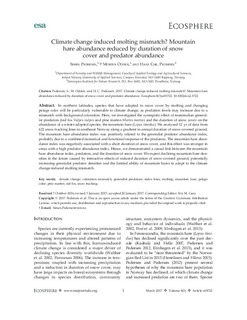Climate change induced molting mismatch? Mountain hare abundance reduced by duration of snowcover and predator abundance
Peer reviewed, Journal article
Permanent lenke
http://hdl.handle.net/11250/2448494Utgivelsesdato
2017Metadata
Vis full innførselSamlinger
Sammendrag
In northern latitudes, species that have adapted to snow cover by molting and changing pelage color will be particularly vulnerable to climate change, as predation levels may increase due to a mismatch with background coloration. Here, we investigated the synergistic effect of mammalian generalist predators (red fox Vulpes vulpes and pine marten Martes martes) and the duration of snow cover on the abundance of a winter-adapted species, the mountain hare (Lepus timidus). We analyzed 12 yr of data from 622 snow tracking lines in southeast Norway along a gradient in annual duration of snow-covered ground. The mountain hare abundance index was positively related to the generalist predator abundance index, probably due to a combined numerical and functional response of the predators. The mountain hare abundance index was negatively associated with a short duration of snow cover, and this effect was stronger in areas with a high predator abundance index. Hence, we demonstrated a causal link between the mountain hare abundance index, predators, and the duration of snow cover. We expect declining mountain hare densities in the future caused by interactive effects of reduced duration of snow-covered ground, potentially increasing generalist predator densities and the limited ability of mountain hares to adapt to the climate change-induced molting mismatch.
